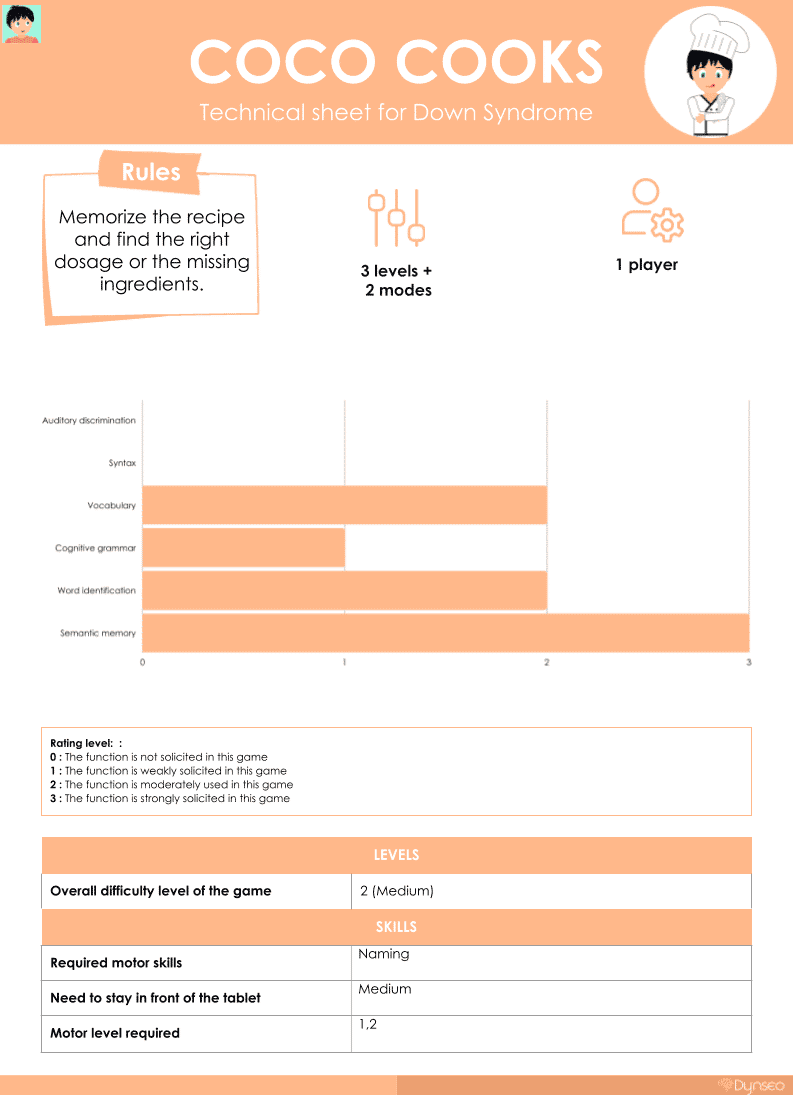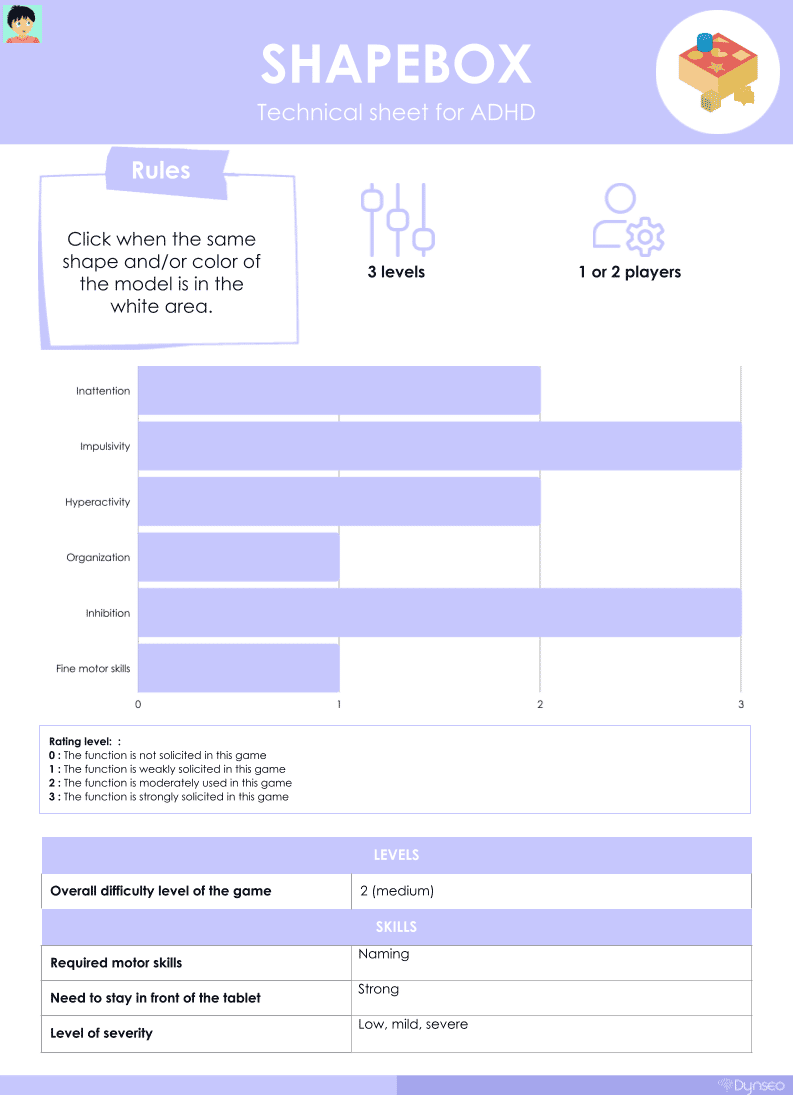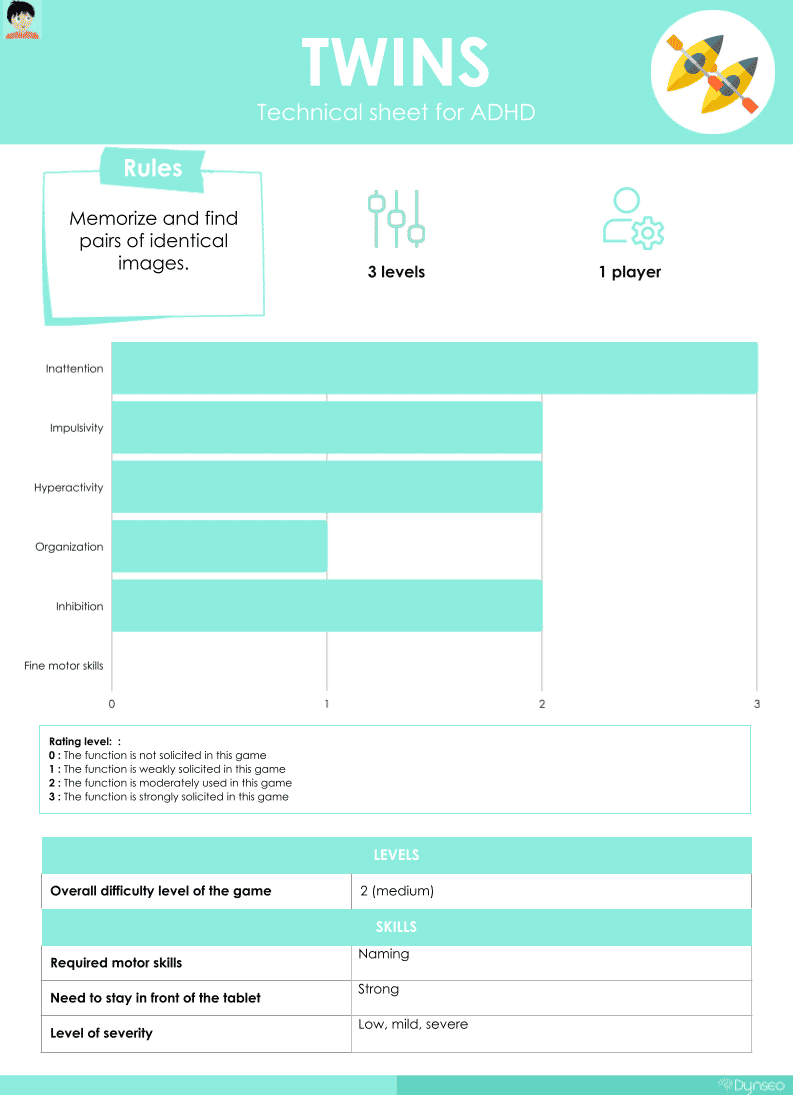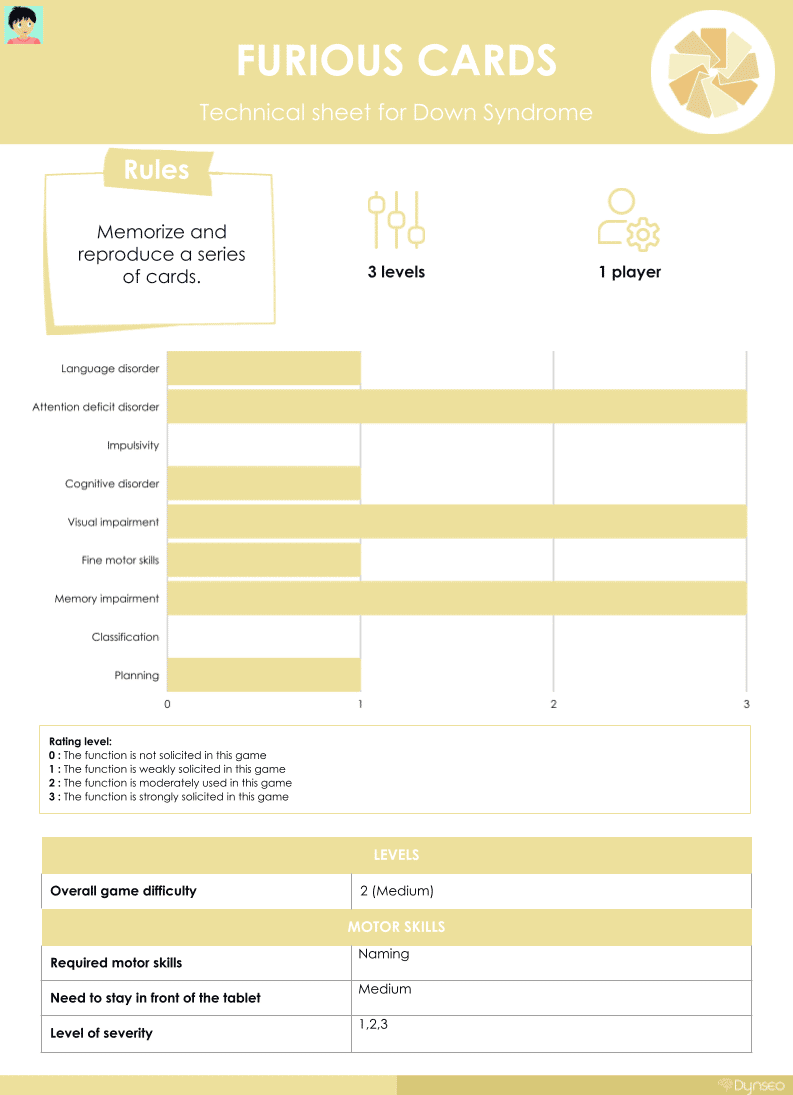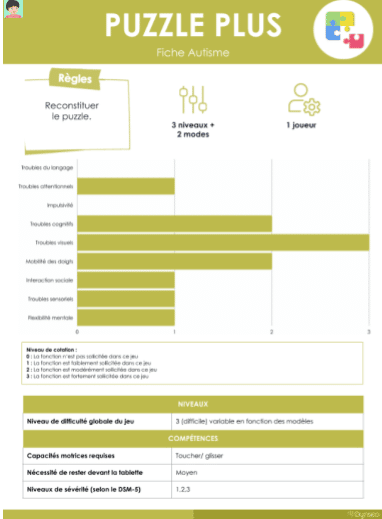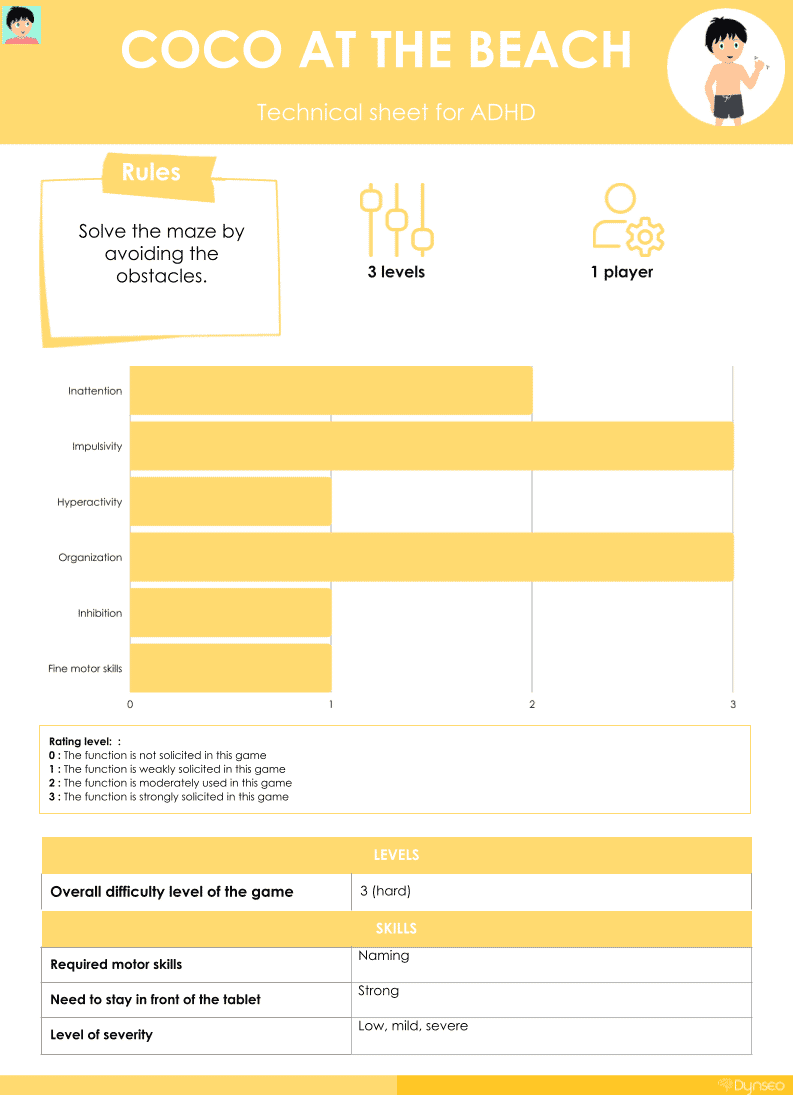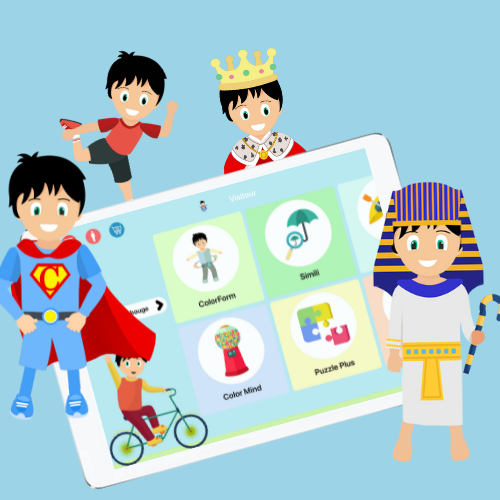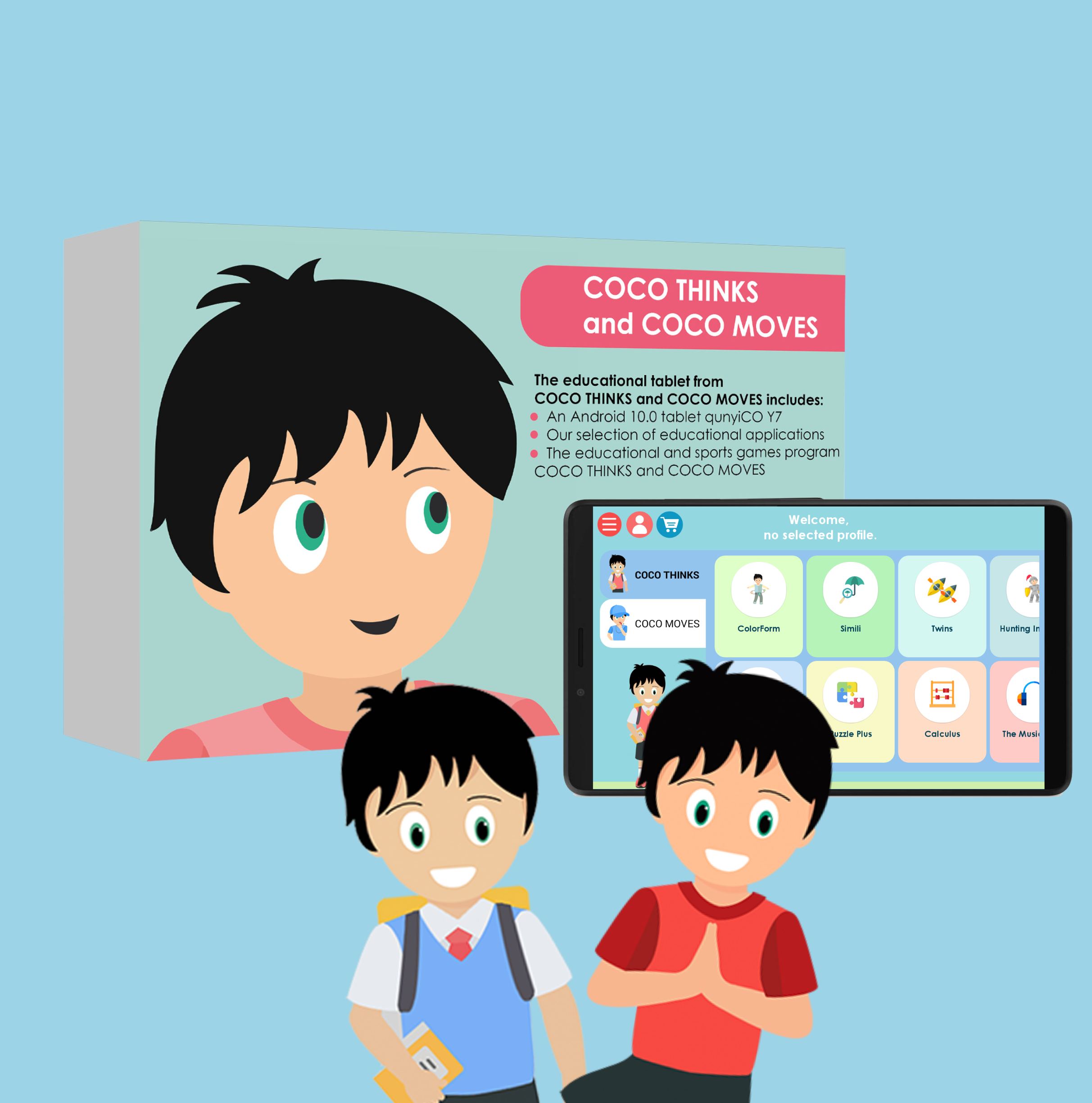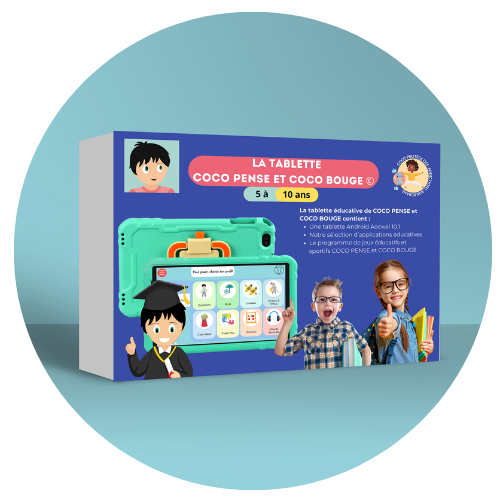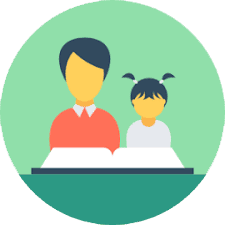Dynseo proposes
SUPPORTING CHILDREN WITH AUTISM with COCO THINKS AND COCO MOVES

Dynseo and its team are very much involved in the development of children, and our goal is to allow all children to develop in harmony and serenity. For some children, development is different, as in the case of children with autism. Supporting children with autism is essential and we will give you every tips to help you in it.
Autism is a developmental disorder that can result in difficulties in language, behavior and social relationships, perception, motor skills or cognitive skills. A child may have many of these difficulties, and we are here to help all children! For us, autistic children are like any other children. It will be up to you for supporting children with autism by offering him/her the most suitable games and levels of difficulty.
Mild Form
Stage 1
Limited social communication
Specific Interests
Repetitive behaviors
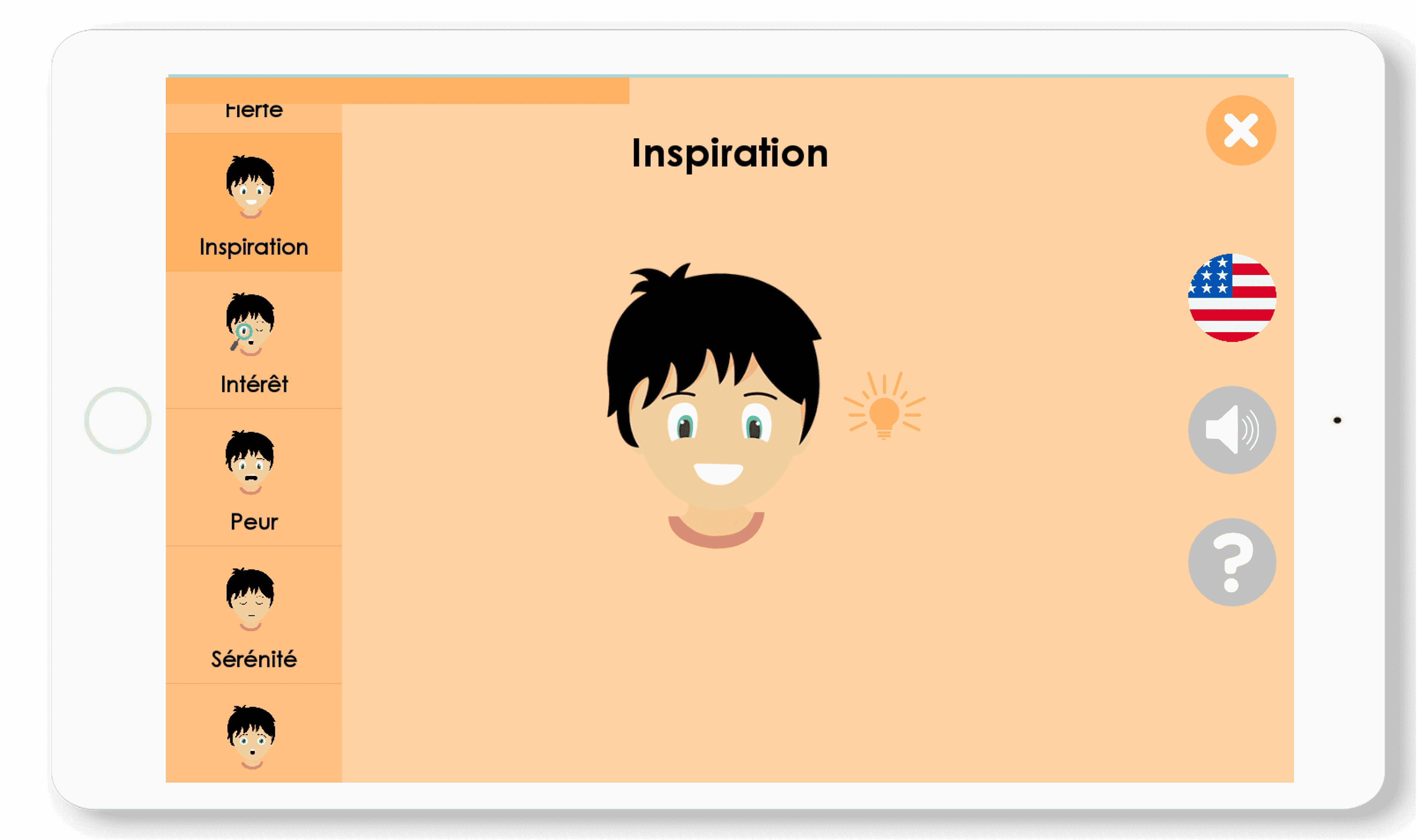
Moderate Form
Stage 2
Isolation
Difficult social interactions
Need to control the environment
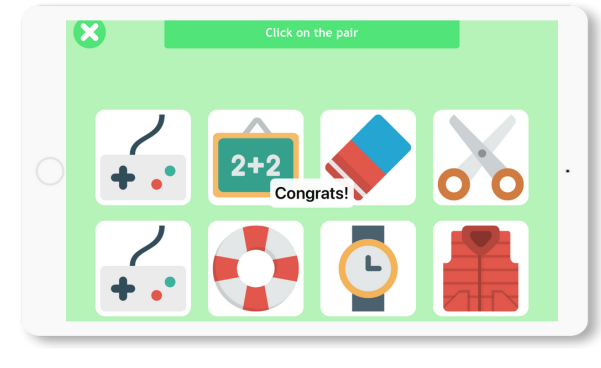
Severe Form
Stage 3
No relationship with others
Fixed ideas
Difficulty changing habits of behavior

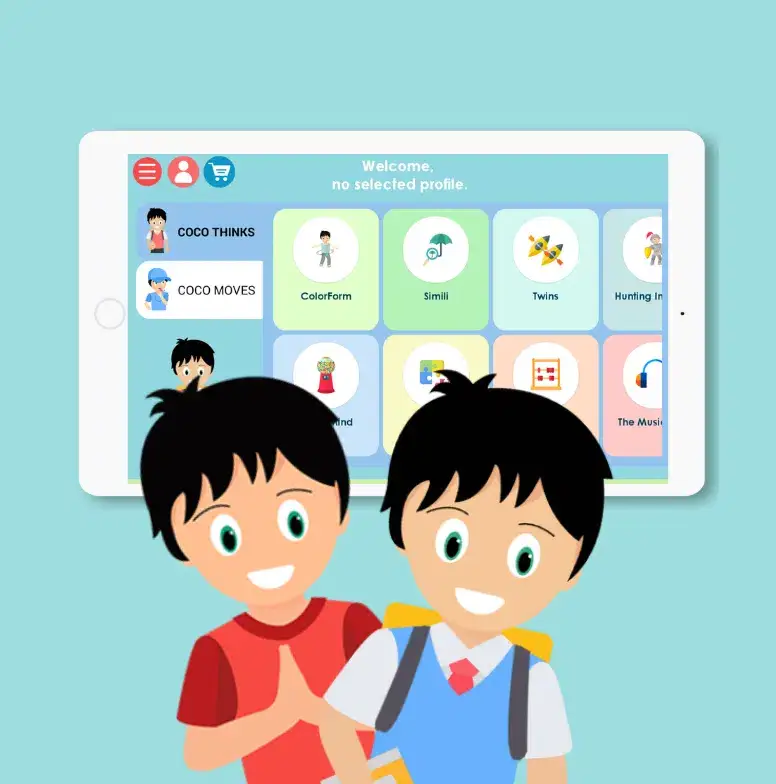
COCO, THE DYNSEO PROPOSAL
Today, COCO is an application used by autistic children either at home or with a healthcare professional, who may be a speech therapist, occupational therapist, psychologist or psychomotor therapist. All professionals wishing to subscribe to Coco can benefit from a web-based performance tracking platform. It is therefore possible to see the evolution and improvement of people with autism, and thus personalize their care.
Coco goes everywhere with you, because the application doesn’t need Wi-Fi to work, Wi-Fi is only needed for updates.
It’s perfectly possible to work with a person with autism by proposing activities adapted to their needs. In the Coco app, there are over 30 games adapted for children to stimulate the various cognitive functions effectively while having fun.
Children with autism are often followed by several therapists. but we mustn’t forget that they’re still children, and children need to play and have fun.
Coco therefore offers a solution that takes into account both the child’s side (by offering fun games) and the professional’s side (by offering cognitive stimulation games). It’s a win-win situation!
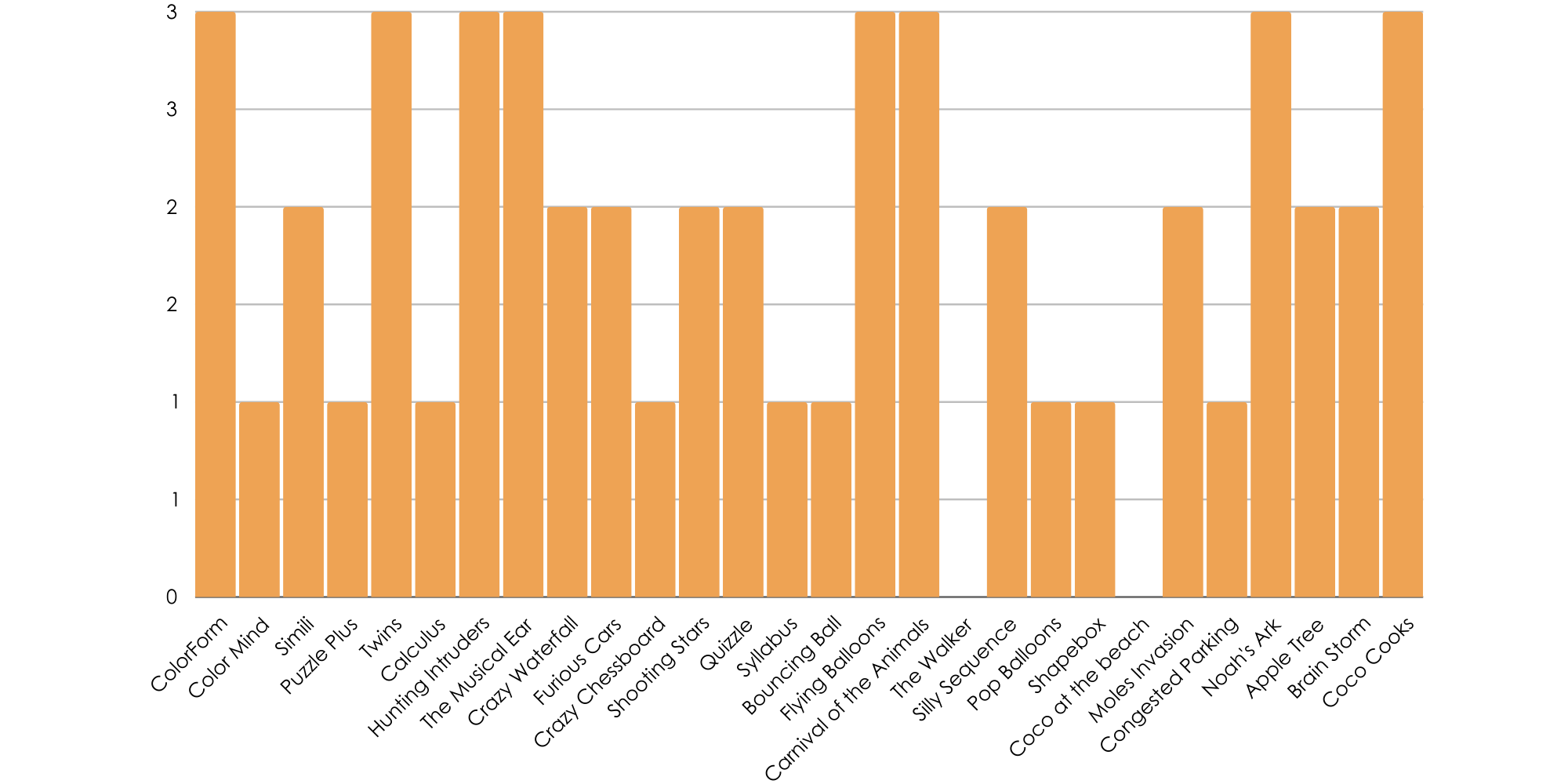
Coco games adapted to autism needs
Filters
to suit every Child’s needs
With COCO THINKS and COCO MOVES, children’s cognitive training moves up a gear: it is personalized, relevant, and without failure.
With the filters, you can view games by specific need (Autism) or by target cognitive function.
Our latest feature enables healthcare professionals and caregivers to improve children’s cognitive functions through engaging games, targeting pathologies such as ADHD, autism and learning disabilities.
What’s more, COCO THINKS and COCO MOVES emphasizes inclusiveness. It recognizes that every child is unique, and the application’s filters take into account the diversity of cognitive abilities and challenges children may face.
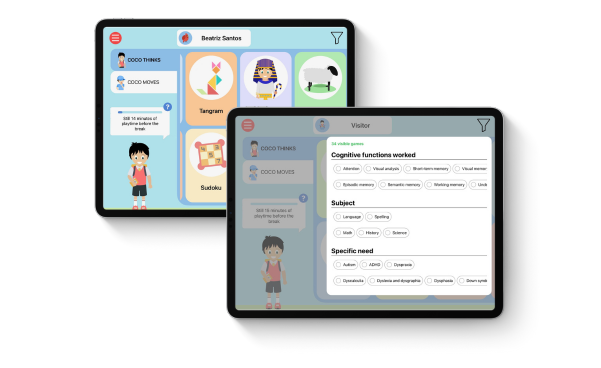
Possibility to filter the games dedicated to autistic children
IN THIS GUIDE
01.
Games adapted according to the form of autism
Explore the diversity of games designed specifically to accommodate different autism spectrums, providing enriching and inclusive play experiences for all.
02.
Areas of fragility in autism
Identify and understand areas of fragility of children with autism to better support them, highlighting the unique challenges they face and proposing tailored strategies to strengthen their well–being.
03.
Monitoring the learning of children with autism
To support the evolution of learning in autistic children through personalized follow–up methods, aimed at maximizing their potential while respecting their rhythm and specific needs.
04.
BONUS: the benefits of taking a sports break for an autistic child
To highlight the benefits of sports breaks for children with autism, a practice that not only promotes improved coordination and fitness, but also contributes to stress reduction, improved concentration and social development, thus supporting their overall development.
I would like to receive the complete guide to accompanying autistic children with
COCO THINKS and COCO MOVES
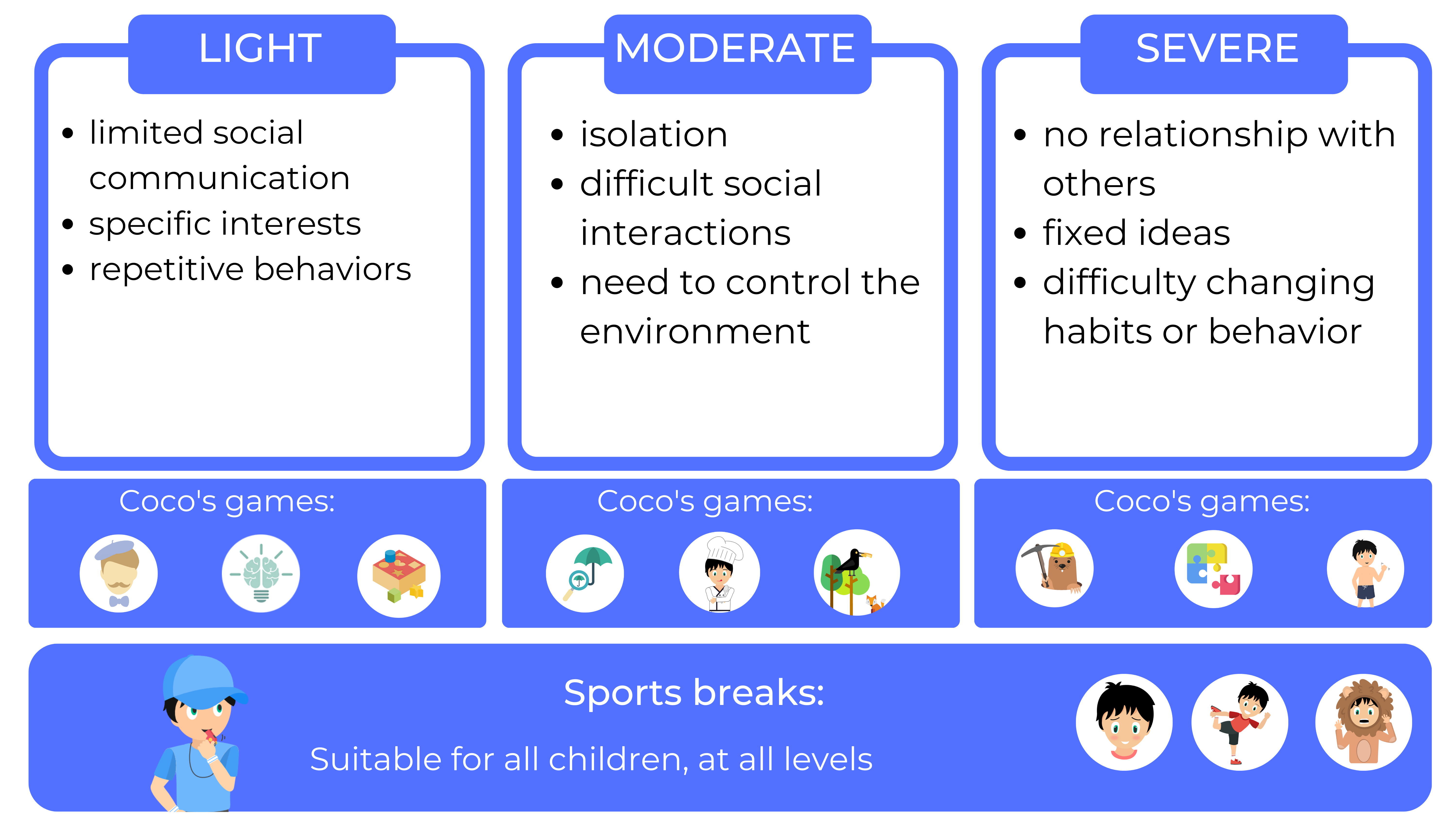
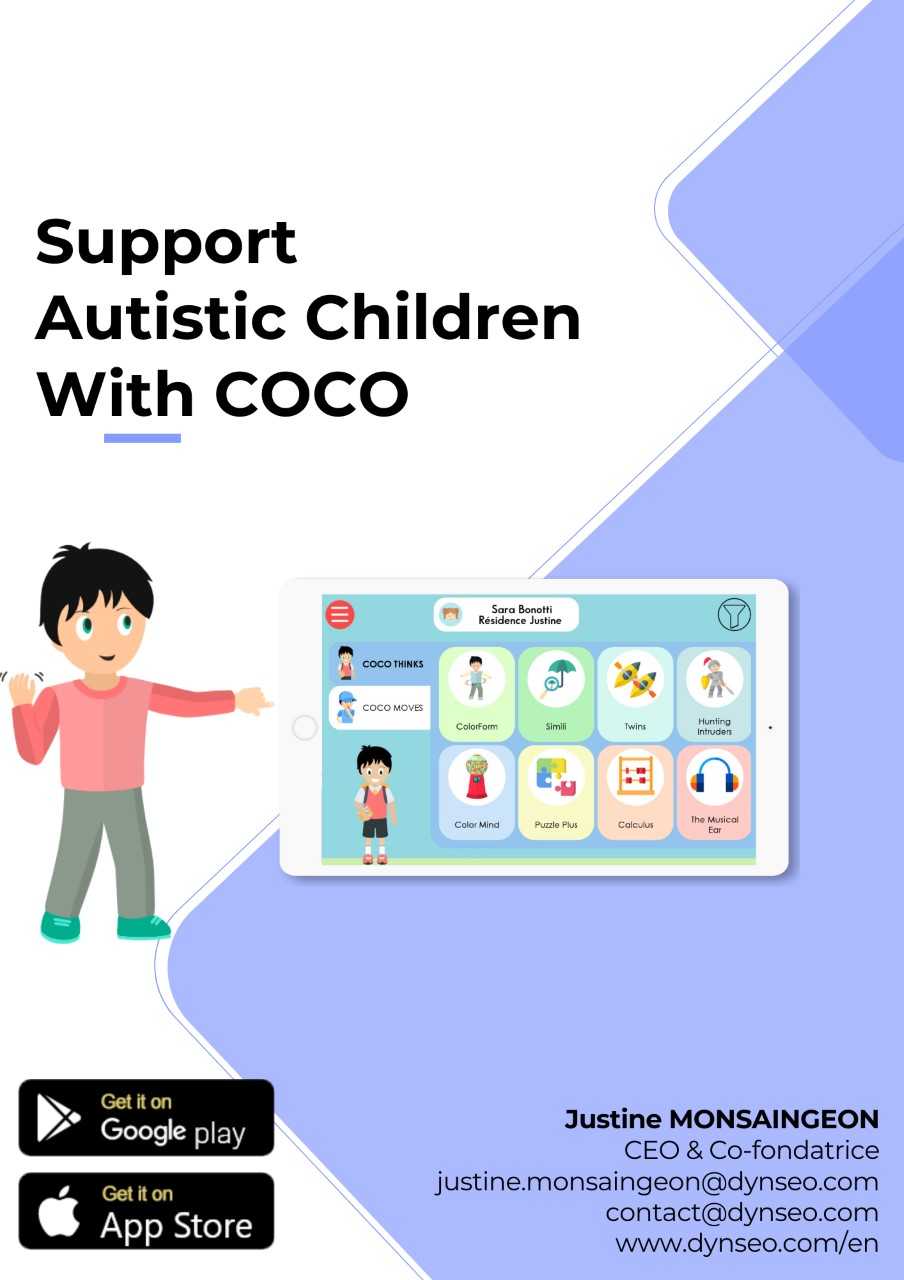
01.
GAMES ADAPTED ACCORDING TO THE FORM OF AUTISM
Discover the most suitable games for autistic children within the COCO THINKS and COCO MOVES program.
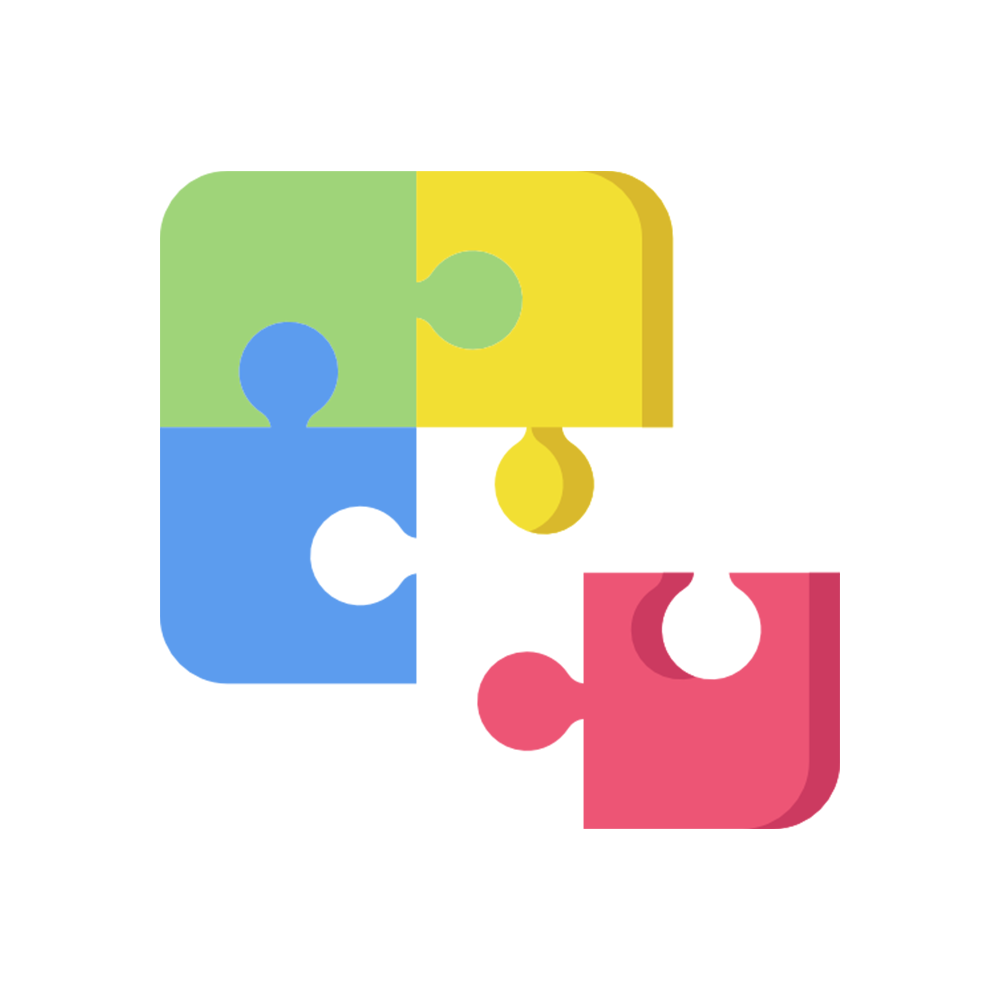
Puzzle Plus

Moles Invasion

Mime emotions
FORMS OF AUTISM
There are different forms of autism, so every child is different, with specific difficulties and needs. It is therefore important to personalize the work for each child. With Coco, this personalization is possible, as the application adapts to the child and his or her needs, as well as to the professional and his or her therapeutic objectives.
Thanks to 3 levels of difficulty, Coco can be used and adapted to every stage of autism.
Stage 1 – Autism
At this stage, the child has trouble with social interaction, and has difficulty communicating or understanding others. He may also show low investment in relationships and utter atypical phrases. We may also find specific, restricted interests or repetitive behavior.
Quizzle
Answer general knowledge questions.
With this game, you stimulate conversation thanks to the question/answer format. You can choose the basic form to stimulate the formulation of coherent, appropriate responses. You can then ask for a more in-depth response to stimulate dialogue.
The question/answer format also helps you to understand how the conversation is going, to give the other person space and to listen.
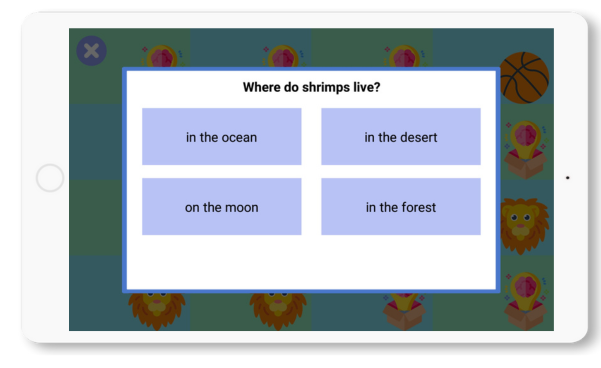
This game also stimulates attention and comprehension to understand the question, and memory to find the right answer.
Brain Storm
Put the words in the right order to create the proverb.
This game stimulates both functional language (cognitive function) and social language (social communication).
The child has to read and understand the different words. He must then create a mental image to try out the possible combinations until he finds the right order.
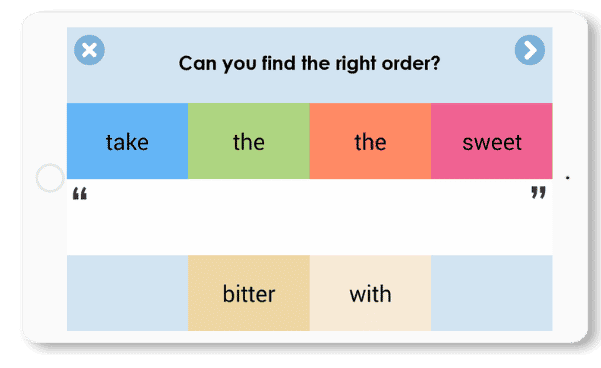
With this game, you can also work on social language. With proverbs, you stimulate understanding and differentiation between the literal and figurative meanings of words/phrases. For example, the proverb “the best soup comes from an old pot” doesn’t literally mean that to make good soup, you have to use an old pot, but that experience is important if you want to improve.
The child can also learn proverbs and better recognize them in conversations and act appropriately.
Stage 2 – Autism
At this stage, symptoms are more pronounced, with the child becoming isolated and having difficulty interacting with others. Children can become frustrated when they can’t control their environment, if they can’t control a behavior or if there are too many external stimuli that are difficult to manage.
Simili
Find the duplicate image between the proposed images.
With this game, you stimulate active research in the child. The proposed images change with each round (10 rounds per game), so the stimuli present continue to change and the child must adapt to the proposed images without knowing which ones will appear.
The task, however, remains fixed for the duration of the game, and the child has a known context in which to play. To find the duplicate image, you stimulate visual scanning and visual analysis to identify each image.
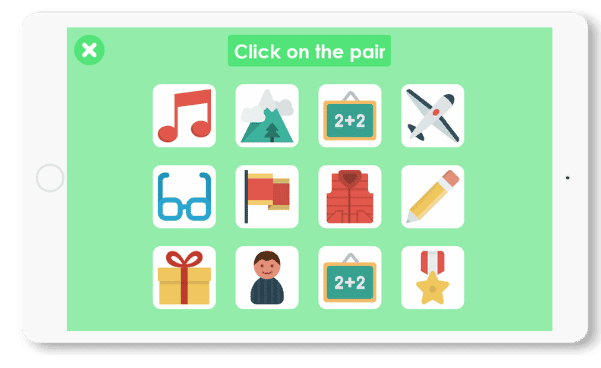
Finally, you can use this game together to maintain the relationship. The first to find the duplicate image must touch it on the screen or say the name of the image.
Coco Cooks
Memorize the recipe or its ingredients.
Thanks to this game, you can stimulate different cognitive functions and social relationships at the same time.
In the first phase, the game shows the recipe and the child has to memorize the ingredients.
You can stimulate sequencing in the “recipe” mode (the child has to remember the procedure) or verbal or visual memory in the “ingredients” mode (the child has to remember the ingredients).
These skills are fundamental to creating and maintaining autonomy.
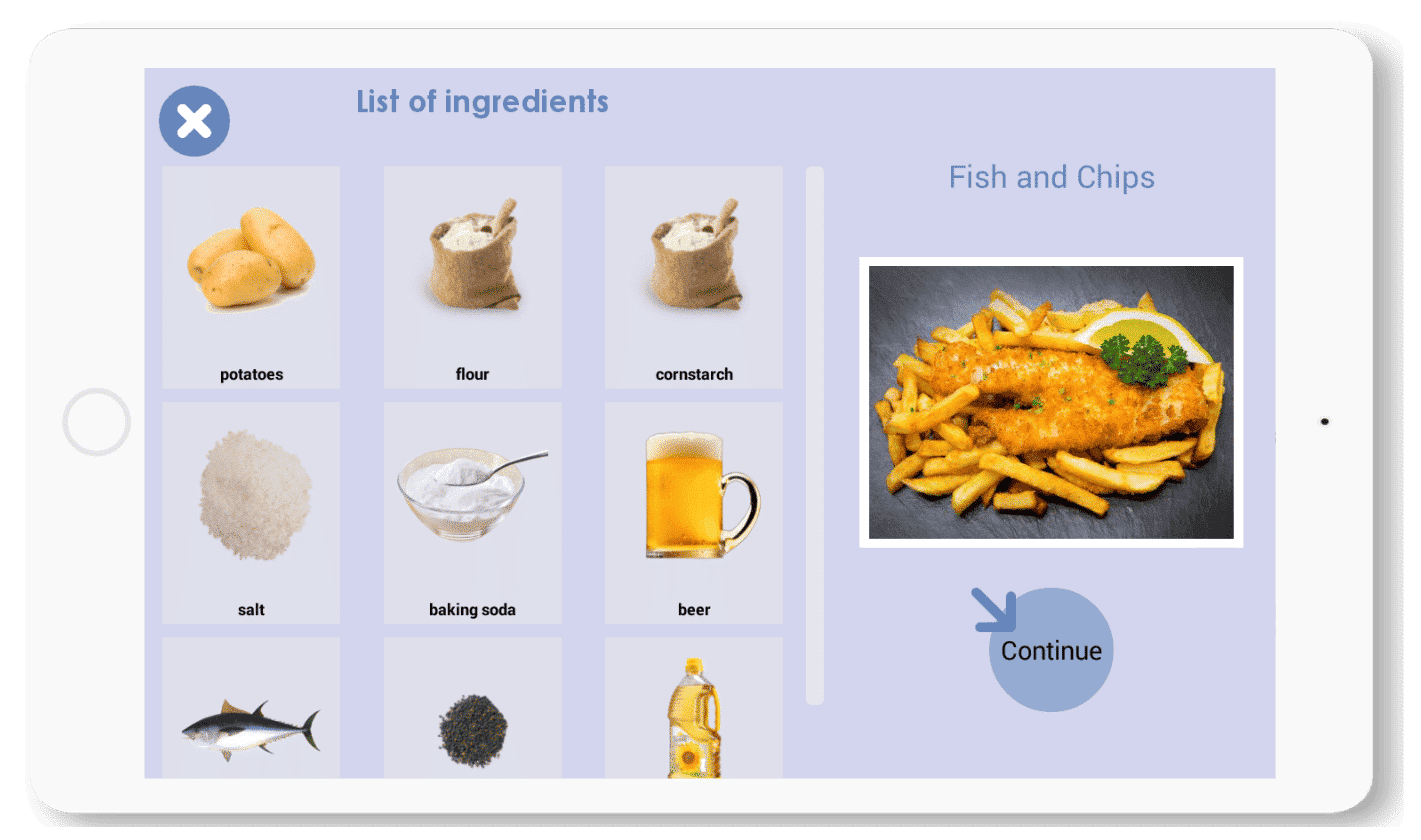
Finally, to maintain the relationship, you can also look up a recipe on the game, memorize the steps or ingredients and cook it for real!
Stage 3 – Autism
At this stage, the difficulties are more severe. The child is unable to communicate with others or form relationships. He may have fixed, repetitive ideas that the child can’t let go of. We can see a difficulty in changing mental patterns and a strong frustration when something doesn’t go as planned.
Moles Invasion
Tap the moles as soon as they appear on the screen.
This game stimulates activation and inhibition, as there are 3 different moles requiring different actions: the normal mole must be touched once, the mole with the helmet twice and the mole with the glasses must not be touched.

The child must use visual scanning to locate and identify the mole. He must adapt his behavior to the type of mole. The action to be taken is not always the same, so the child has to change his mental schema to act according to the stimuli present.
This game can also be played in pairs, with the screen divided into two parts. You can use it to maintain the relationship with the child and share the game with him.
Puzzle Plus
Create puzzles with the pieces on hand.
Puzzles are easy games that children at a more severe stage of autism can also play.
In this game you can find different images or photos. The child can then discover something new every day.
With several images available, it’s easier to change the child’s point of interest.
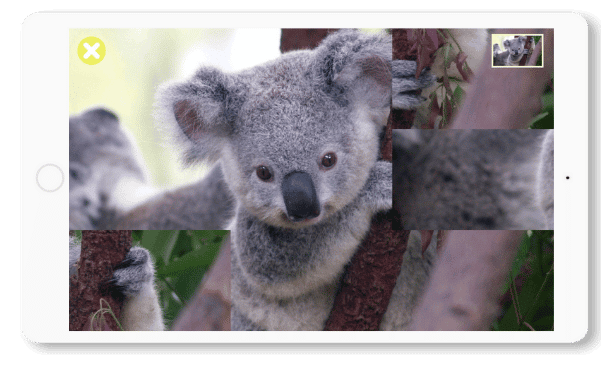
What’s more, if a piece isn’t in the right place, the child can still move it to find the right solution. This allows the child to make several attempts and learn to deal with frustration.
All stages – Recognizing emotions
In our educational application COCO, you can also learn to recognize your emotions with the game “Mime emotions”, in the COCO MOVES section. By clicking on the question mark, you will be able to learn the different emotions in order to better recognize them.
This game to mime emotions is also accessible as a break, every 15 minutes of screen. Every 15 minutes, children are asked to choose a physical activity for an active break. And you can also mime the emotions at that time!
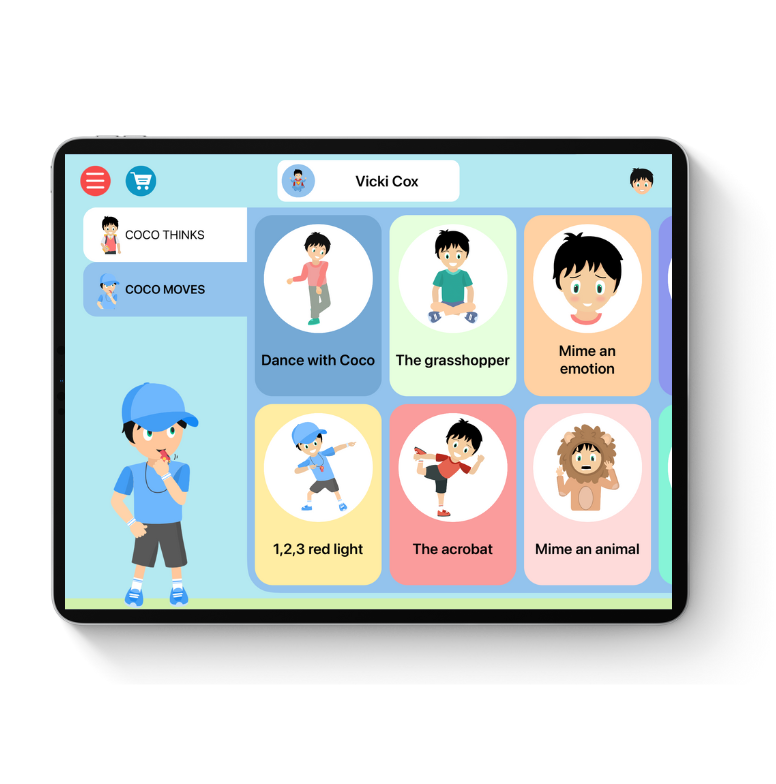
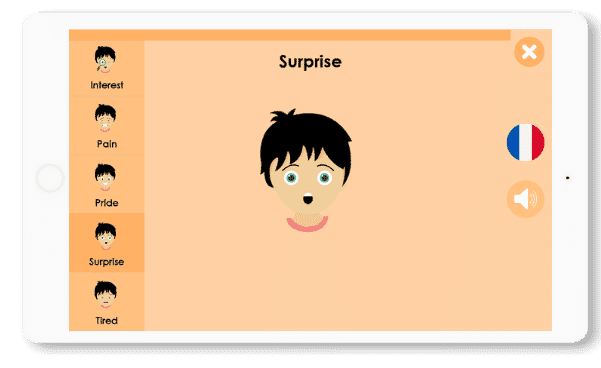
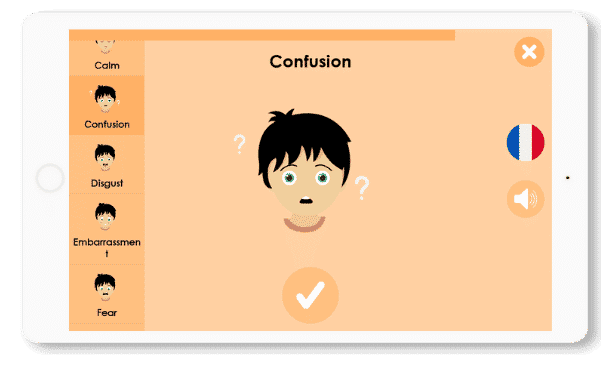
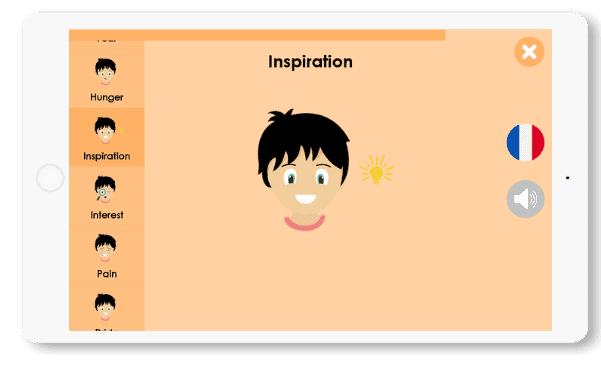
SURPRISE
Surprise means that you are surprised by a moment, a person or an object. Like an unexpected gift!
When you are surprised, you open your mouth and eyes wide.
CONFUSION
Confusion is being lost in our ideas because of an event for example. It is possible to make a mistake about the name of someone or something.
To mimic confusion, open your eyes wide, make a big “Hoo” with your mouth and raise your eyebrows.
INSPIRATION
Inspiration is the ability of our mind to imagine and create things like drawings, poems, stories.
For inspiration, we’ll squint our eyes, scratch our heads lightly with a smile and pretend to paint, write or draw.
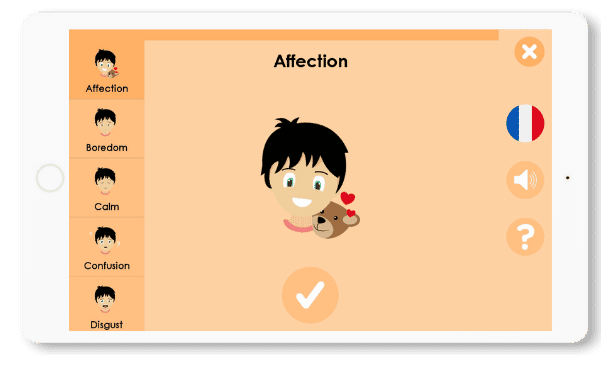
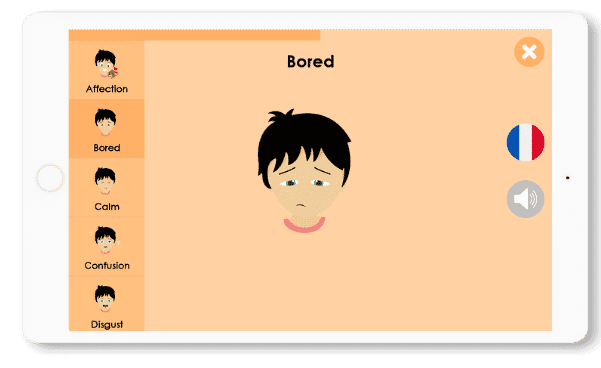
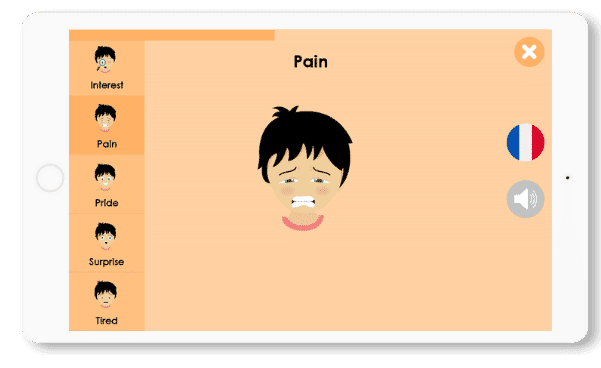
AFFECTION
Affection means to be touched, to have positive thoughts for a friend, family member or pet.
Here, we smile, we think about the good times, we can hug, kiss, tell a friend that we like him or her.
.
BOREDOM
Boredom is present when we are in a situation that does not interest us. You don’t want to listen to the person in front of you or you don’t want to do anything.
For boredom, we’ll blow hard, look up and look around.
PAIN
Pain is an unpleasant sensation that can hurt. It can hurt physically with an accident. Pain can also be a feeling of missing someone or something or sadness.
To express the pain we raise the eyebrows upwards, we bend the eyes and we make a grimace with the face.
02.
AREAS OF FRAGILITY IN AUTISM
A child with autism may therefore encounter a variety of difficulties, in different areas of development and with different intensity. COCO can be adapted for each stage of autism, and can also be adapted to the cognitive functions to be stimulated.

Twins
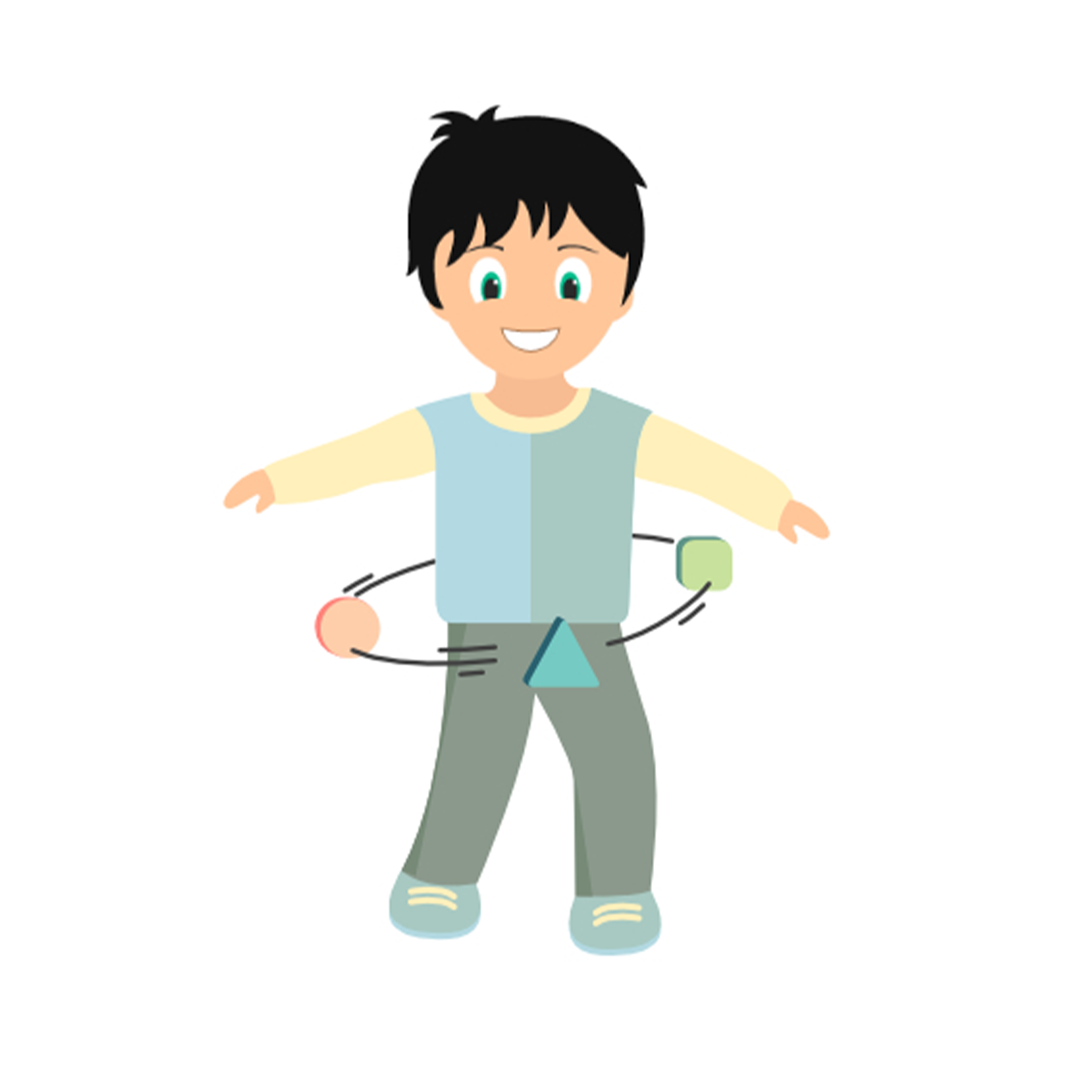
ColorForm
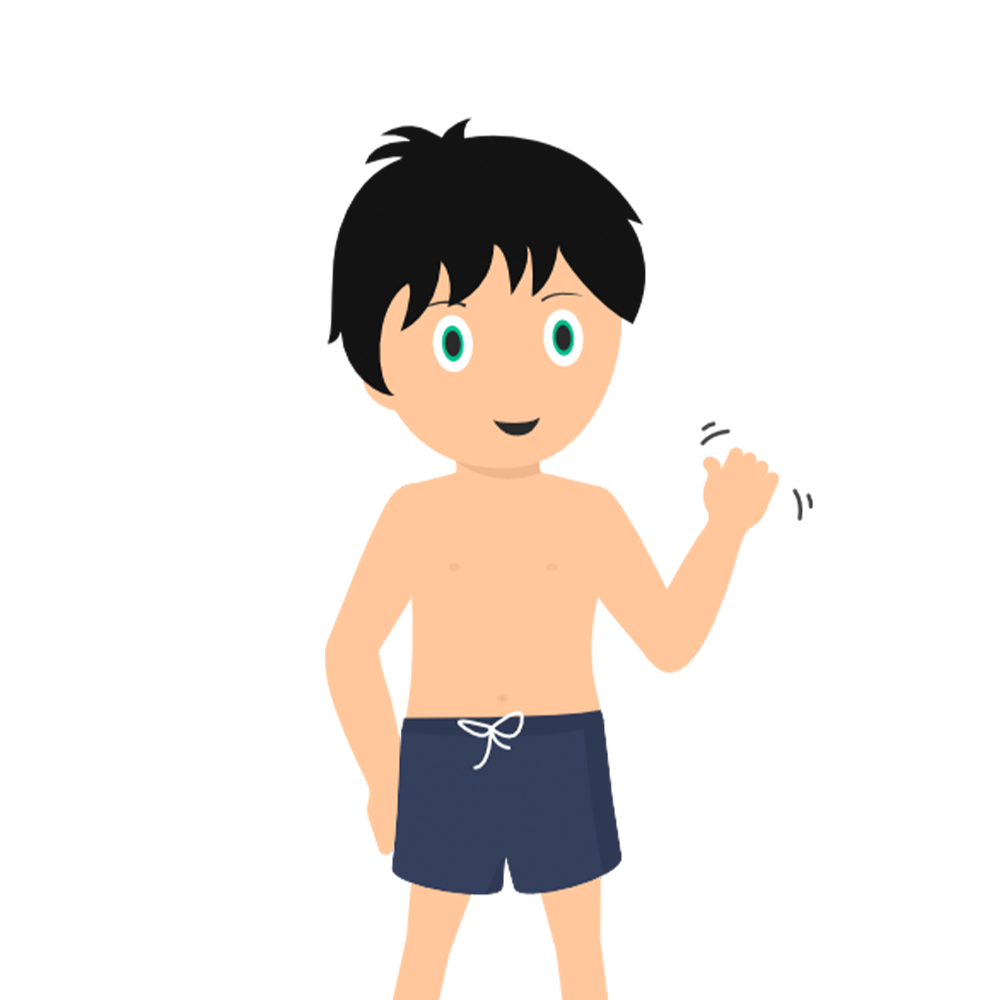
Coco at the beach
Social interaction in children with autism
Children with autism have difficulties in social relationships because they can’t understand non-verbal language, irony or sentence innuendo. They also have difficulty understanding other people’s moods or expressing their emotions. Coco allows two players to play in certain games, enabling children to create relationships in a protected context and learn strategies for relating to others and managing emotions.
Shapebox
Find the right shape or color for the model.
In two-player mode, each player has a button on his or her own side of the screen, and objects move to the middle of the screen. So you have to share the tablet and look at the same objects.
In one game, there are 10 shapes to spot according to the patterns, so each player can earn points.
The child can learn to accept losing points during the game, but winning in the end, so he can learn to lose by tolerating frustration.
During this game, the child can express several types of emotions and learn to manage them better.
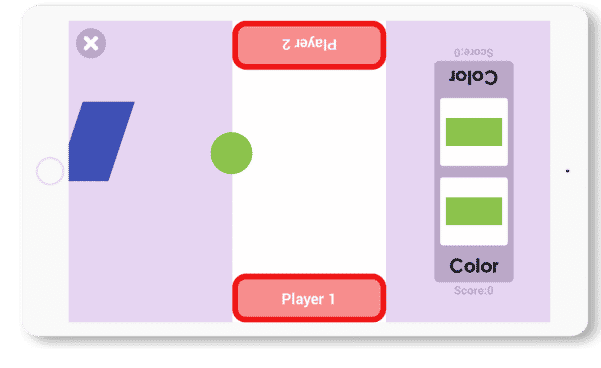
Twins
Memorize the position of the cards and find the duplicate images as in the Memory game.
Memorize the position of the cards and find the duplicate images as in a “memory” game.
In this game, two players take turns. You can stimulate sharing of the deck, but also rotation and waiting for the other player (waiting for the other player to think about his or her move and touch the cards to be turned).
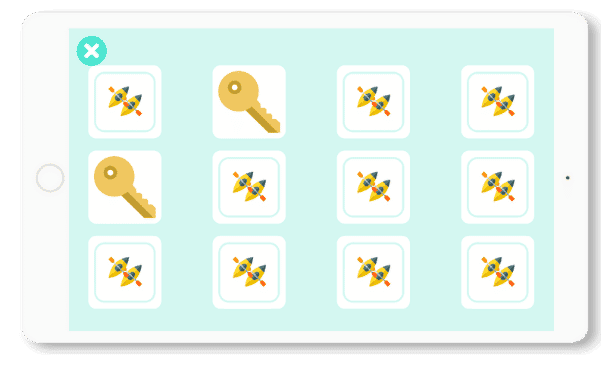
Memory games are familiar to all children, and children with autism can play them with their friends.
Finally, with this game you can stimulate other cognitive functions such as visual scanning, visual memory and immediate memory.
Interests and behavior of autistic children
Children with autism have restricted interests that can become fixed ideas that they can’t shake off. This fixation can give rise to atypical behavior, as the person may have stereotyped movements or rituals (for example, before leaving a doorway, he or she has to stamp his or her feet on the floor). These fixations and rituals lead the child to have fixed and limited mental patterns. Enriching or modifying the mental patterns they use is very difficult for them.
ColorForm
Find the same shape or color as the model.
In this game, the request can change with each turn (10 turns per game), so the child has to adapt to the request.
The aim of the game can be to find the shape, the color or the shape and color together.

This activation or inhibition requires the child to change mental patterns several times and adapt to an external stimulus.
You also stimulate visual perception, attention, hand-eye coordination and reflexes. All these cognitive functions help children to enrich their mental schemas and find new strategies.
Cognitive stimulation for supporting children with autism
Children with autism may also have a cognitive delay, manifested by disorders in executive functions such as attention, memory, logic and planning. Cognitive impairment is not present in all forms of autism, but when it is, it’s important to keep a close eye on the child.
Color Mind
Remember the color sequence.
The colors are easy to recognize, so you can use this game with children with severe cognitive impairment.
First, you visualize a sequence of colors, and the child has to remember and reproduce the sequence.
This game stimulates attention and memory.

What’s more, each color is associated with a different sound: you can also stimulate auditory discrimination or auditory memory.
Finally, this game helps to increase memory capacity, as the difficulty of memorizing color combinations increases with the child’s success.
Coco at the beach
Find the best route to return the ball to Coco.
To move the ball you have arrows on the right. Depending on the possible directions, you’ll see only the arrows indicating those directions. This adaptation will enable the game to be used with children with more severe cognitive disorders.
This game stimulates visuo-spatial construction, as the child has to imagine the ball’s movements in space.
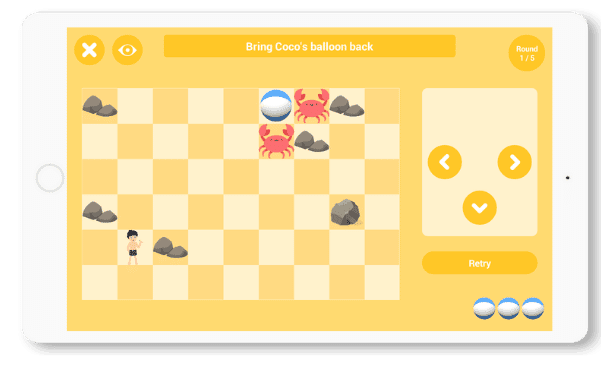
In this game, it’s possible to ask for clues: you can stimulate the use of feedback and help the child adapt to the instructions and clues he receives.
03.
ADAPTATION AND FOLLOW-UP OF AUTISTIC CHILDREN
Autism is a developmental disorder that affects the way a person communicates, interacts socially, and perceives the world around them. For children with this disorder, careful monitoring of their progress in various areas of learning is essential to tailor educational interventions in a personalized and effective manner.
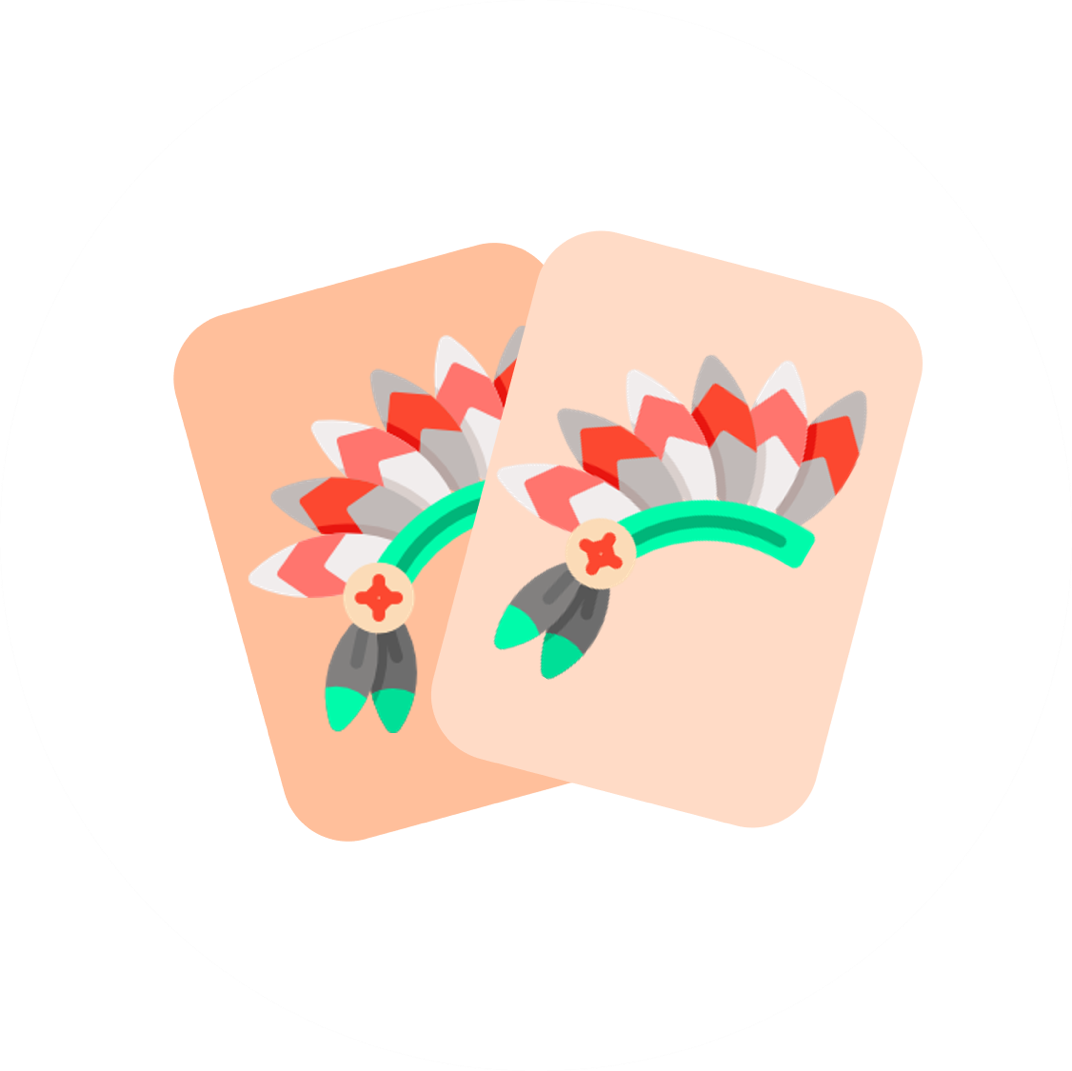
Furious cards
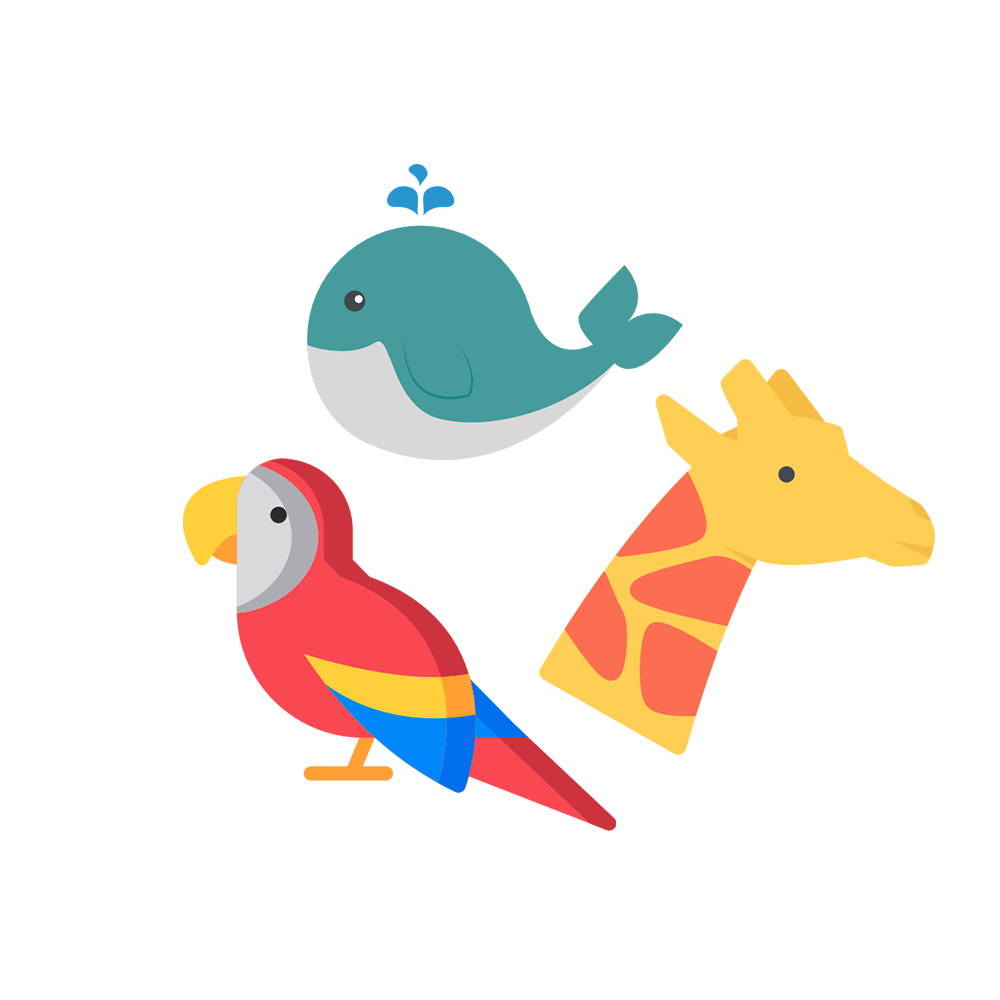
Carnival of the animals

Colormind
Working with a child with autism is not always straightforward, since different areas of development need to be considered, and the severity of the disorder varies from situation to situation. Coco also offers 3 levels of difficulty: the child can use the application at his or her own level, but the application can also follow the child’s progress (for example, the child can start at the easy level and move up to the medium level once better skills have been achieved). The games are designed to follow children’s development according to their age, skills and needs.
Furious Cards
Remember the order of the cards.
The images are simple enough for children to recognize.
Depending on the level, there is a different number of cards to memorize (3, 4 or 5). At 3-4 years, memory capacity is 3 elements, at 4-5 years 4 elements and at 5 years 5 elements.
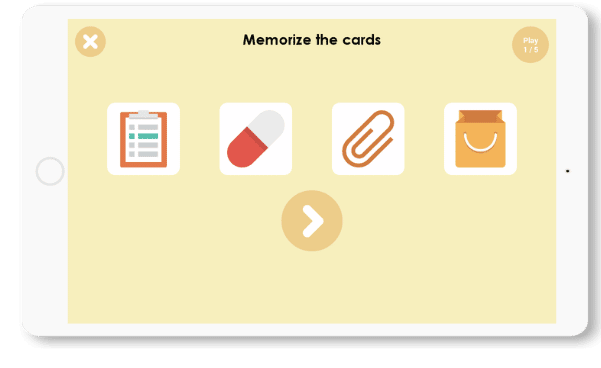
This game allows you to adapt the level to the child’s abilities and to follow his or her progress.
The game also stimulates memory and other cognitive functions. For example, if the child has good visual skills, he or she can focus on images. If he has good verbal skills, he can memorize the names of the pictures.
Carnival of the animals
Match each animal to its habitat.
In the Easy level, we only ask you to differentiate between land, sky and sea animals (three possible habitats).
You can stimulate a first basic classification and look for common features (aquatic animals have fins).
But beware of exceptions: for example, the crab lives in the water but has no flippers.
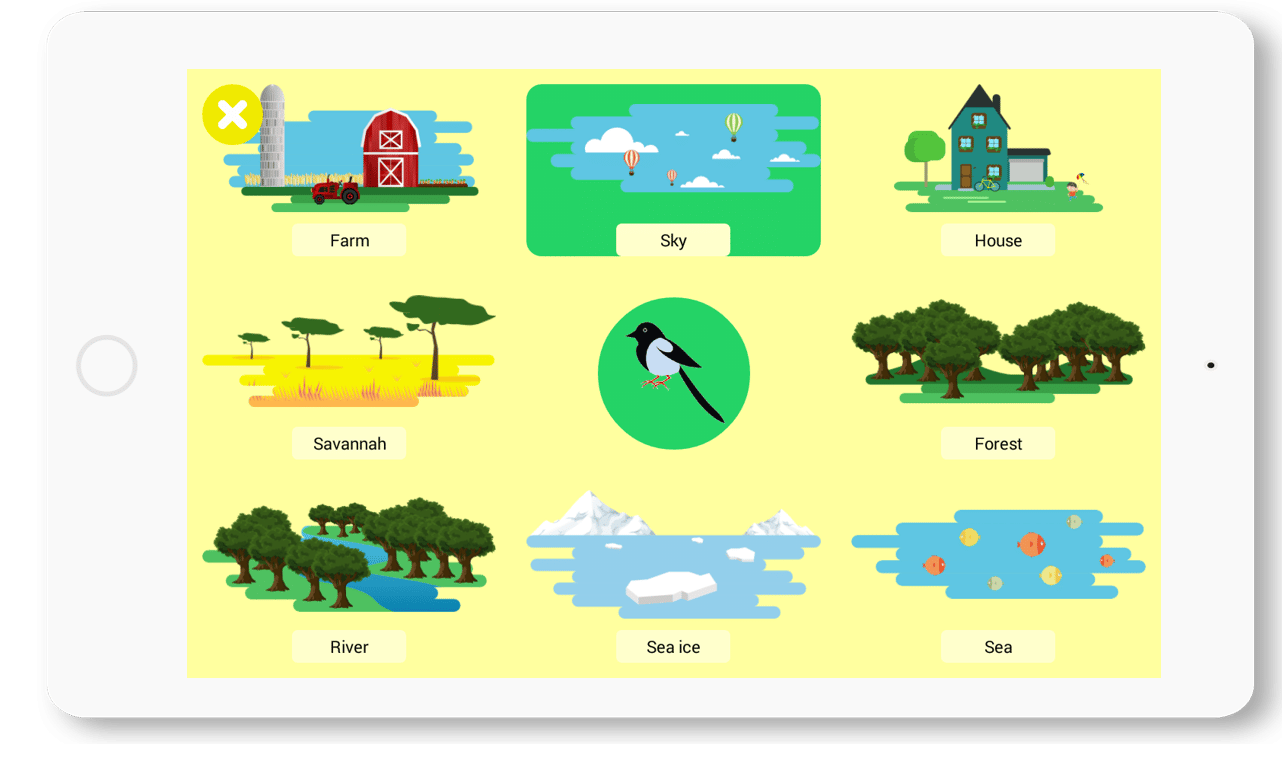
The presence of exceptions is very important for autistic children, as it helps them learn to break out of the pattern and accept something that “isn’t logic”.
In the medium and difficult levels, there are eight possible habitats. These levels require major identification and analysis. The child should focus not only on the characteristics of the animals, but also on the characteristics of the habitats.
MONITORING THE LEARNING OF AUTISTIC CHILDREN
Scores follow-up and adaptation
In the COCO THINKS and COCO MOVES programs, there’s also a function that lets you see your child’s evolution over time. You can see the results obtained and the time spent in each game, for feedback on the work done. This feedback can be useful during therapy to see if the child is achieving the objectives, at school to see the child’s level, or at home to monitor the child’s development.
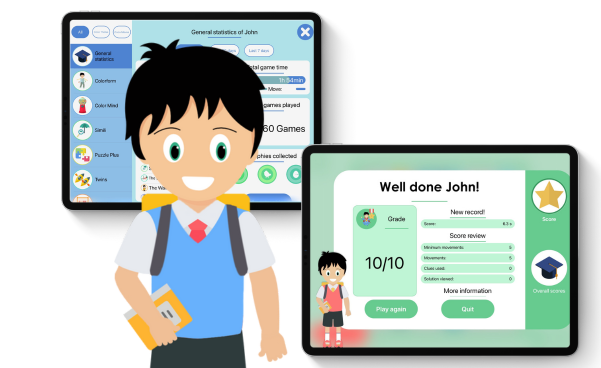
This sports break has many advantages for children, especially those with autism.
Screen use is very useful and loved by children, but prolonged use can become negative. With Coco, children can take a dynamic break, learning to let go of the tablet and engage in physical activity while having fun at the same time.
All our physical activities are designed with children in mind. With balance and dance games, children learn to know their bodies and adapt to their environment. For children with autism, this can be very useful for augmenting known motor patterns and for gaining a better sense of self (especially when there is hypo or hypersensitivity).
In Coco, there’s also the “mime an emotion” game, where the child has to reproduce the emotion shown on screen by Coco. Children can first learn to name emotions, to recognize them in themselves and then in others. What’s more, there’s an audio description in the game that explains the emotion and what you feel in your body.
Practical strategies to implement in order to adapt learning
Adaptation and monitoring of learning in children with autism are crucial for their development. These children may struggle in a variety of areas, but with the right strategies, they can learn and progress significantly. Here are some practical tips for parents and educators:
1. Create a structured environment
-
- Spatial organization : Set up a clearly defined learning space that is free of distractions. Use visual cues to help the child understand where each activity needs to take place.
- Predictable routine : Establish a daily routine. Children with autism often feel more comfortable with predictability, which reduces their anxiety and makes learning easier.
2. Use visual aids
-
- Pictogrammes and communication boards: Visual aids such as pictograms help to understand instructions and structure communication.
- Visual planners: Use visual schedules to show how the day or activity is going. This helps the child anticipate what is going to happen and prepare mentally.
3. Apply specialized teaching methods
-
- Structured instruction: Methods such as TEACCH emphasize organizing the learning environment, activities, and materials in a way that is understandable to the child.
- Applied Behavior Analysis (ABA): This method aims to improve specific social behaviors and teach new skills using positive reinforcement.

4. Foster social interaction
-
- Role-playing and social stories: Practice role-playing to teach social and emotional skills. Social stories can prepare the child for specific social situations by describing the expected behavior in a simple way.
Play/learning groups: Encourage participation in peer groups to develop social skills in a structured and supported environment. - Play/learning groups: Encourage participation in peer groups to develop social skills in a structured and supported environment.
- Role-playing and social stories: Practice role-playing to teach social and emotional skills. Social stories can prepare the child for specific social situations by describing the expected behavior in a simple way.
5. Collaboration between professionals and parents
-
- Regular communication: Ensure smooth communication between parents, educators, and therapists to maintain consistency in educational and therapeutic approaches.
- Training and support: Parents and educators should be trained in specific methods of teaching and supporting children with autism. Look for workshops, seminars, and support groups.
6. Adaptation of learning objectives
-
- Individualization : Tailor learning goals to the child’s abilities and interests. This involves adjusting challenges so that they are achievable, while remaining challenging.
- Track progress : Document and evaluate progress regularly to adjust instructional strategies and goals based on the child’s needs.
These practical tips can go a long way in improving the learning experience for children with autism. It’s essential to keep in mind that every child is unique, and what works for one child may not work for another. Adaptability, patience and understanding are key to best support their development.
04.
SPORTS BREAKS BENEFIT AUTISTIC CHILDREN
Sports breaks provide children with autism with unique opportunities to improve their physical health and emotional well–being. By participating in adapted physical activities, they develop their social skills and build their self–confidence. Regular exercise helps reduce stress and anxiety, providing an effective way to manage emotions. These moments of play and interaction also promote the inclusion and social integration of children with autism into the community.
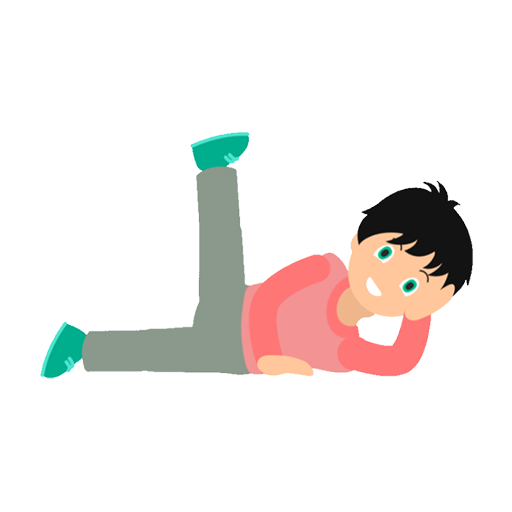
The Yogi Apprentice
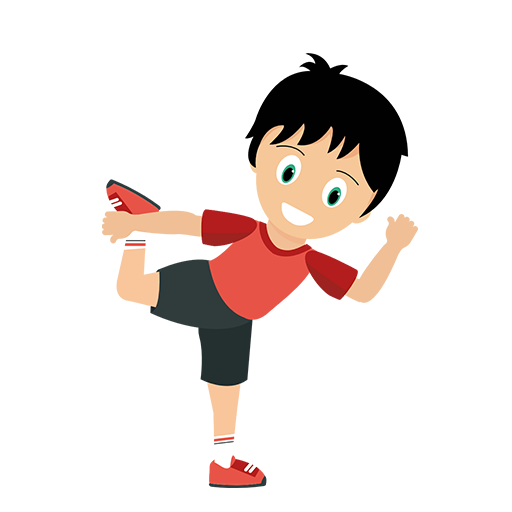
The acrobat
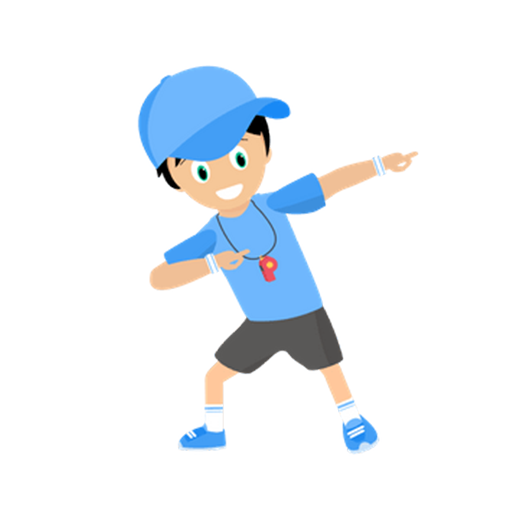
1,2,3 Red light
In COCO THINKS and COCO MOVES you will also find physical activities. Every 15 minutes of screen time, the app stops and offers children physical games.
This sports break has several benefits for children, especially if they have autism.
Screen use is very useful and loved by children, but prolonged use can become negative. With Coco, the child can take a dynamic break, so he learns to let go of the tablet to do a physical activity while having fun at the same time.
All physical activities are designed for children. With balance or dance games, children learn to know their bodies and adapt to the environment. For children with autism, this can be very helpful in increasing known motor patterns and in having a better sense of self (especially when there is hypo or hypersensitivity).
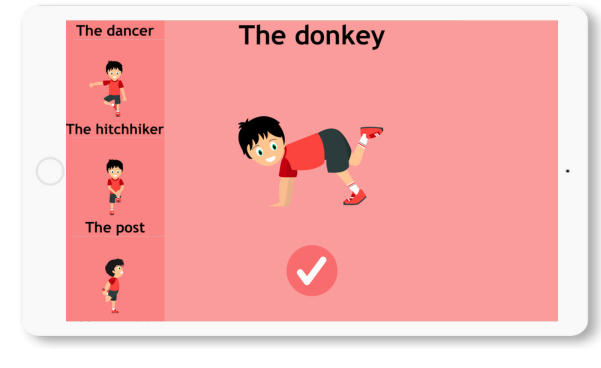
Incorporating scheduled sports breaks provides a predictable structure that can provide reassurance and help manage anxiety about change and uncertainty.Sport plays a vital role in the development of children with autism, providing significant benefits both physically and psychologically. As part of the innovative “Coco thinks and Coco moves“ program, a sports break is imposed every 15 minutes of screen time, thus promoting a healthy balance between cognitive and physical activities. Here are the benefits of this approach:
1. Improved coordination and motor skills
-
- Motor development : Physical activities help improve hand–eye coordination, balance, and fine and gross motor skills. This development is crucial for children with autism, who may face challenges in these areas.
- Active pause : Regular transition from sedentary to physical activity encourages the adoption of a variety of motor behaviours, thus enhancing the body‘s flexibility and adaptability.
2. Reduction of repetitive behaviors
-
- Decreased anxiety : Exercise can reduce stress and anxiety levels, leading to a decrease in the repetitive and self–stimulating behaviors often seen in children with autism.
- Structure and predictability : Incorporating scheduled sports breaks provides a predictable structure that can provide reassurance and help manage anxiety about change and uncertainty.
3. Improved social and communication skills
-
- Group games and activities : Sports and group games encourage social interactions, helping children with autism develop communication skills and understand social cues.
- Confidence building : Participation in sports activities and the development of new skills can improve self–esteem and self–confidence in children with autism.
4. Energy Management & Sleep Enhancement
-
- Energy regulation : Sports breaks help regulate energy levels, allowing for better concentration during cognitive activities. It also helps prevent sensory overload and hyperactivity.
- Better sleep quality : Regular physical activity is associated with improved sleep quality, which is often problematic in children with autism.
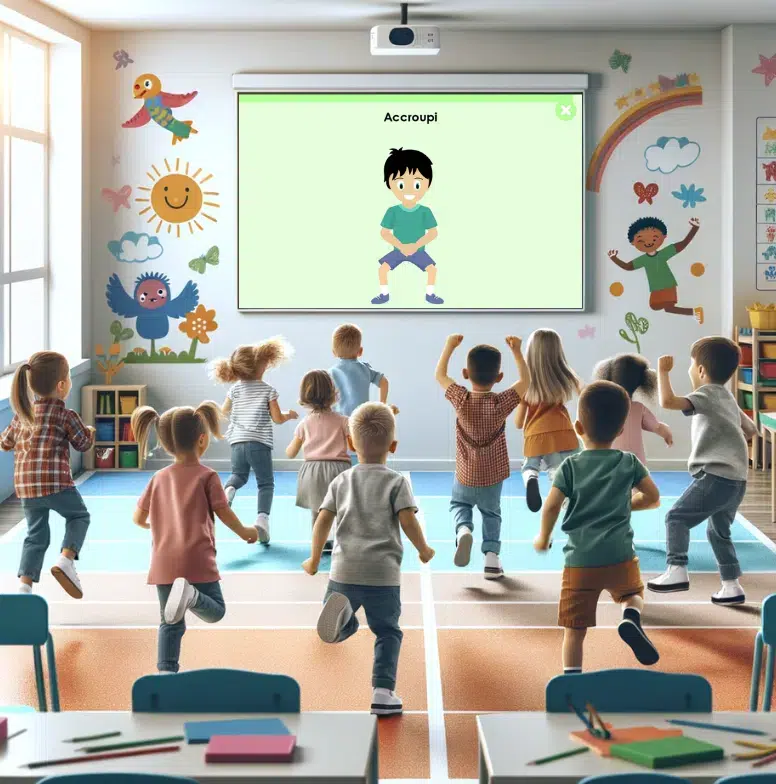
5. Sensory integration
-
- Multisensory stimulation : Sport provides an opportunity to experiment with various sensory stimuli in a controlled manner, helping children to better process and integrate sensory information.
- Reduced sensory sensitivity : Regular exposure to different textures, sounds, and movements can help reduce sensory sensitivity and improve sensory tolerance.
Practical implementation in “Coco Thinks and Coco Moves”
Here are some suggestions to effectively integrate these sports breaks into the program:
- Alternating activities : Vary the sports activities offered during breaks to keep the children interested and engaged. This can include stretching exercises, small ball games, or simple obstacle courses.
- Clear and visual instructions : Use simple instructions and use visual aids to explain sports activities, making the information accessible to all children, regardless of their level of communication.
- Encouragement and positive reinforcement : Provide encouragement and positive feedback to motivate children and recognize their efforts and achievements in sports activities.
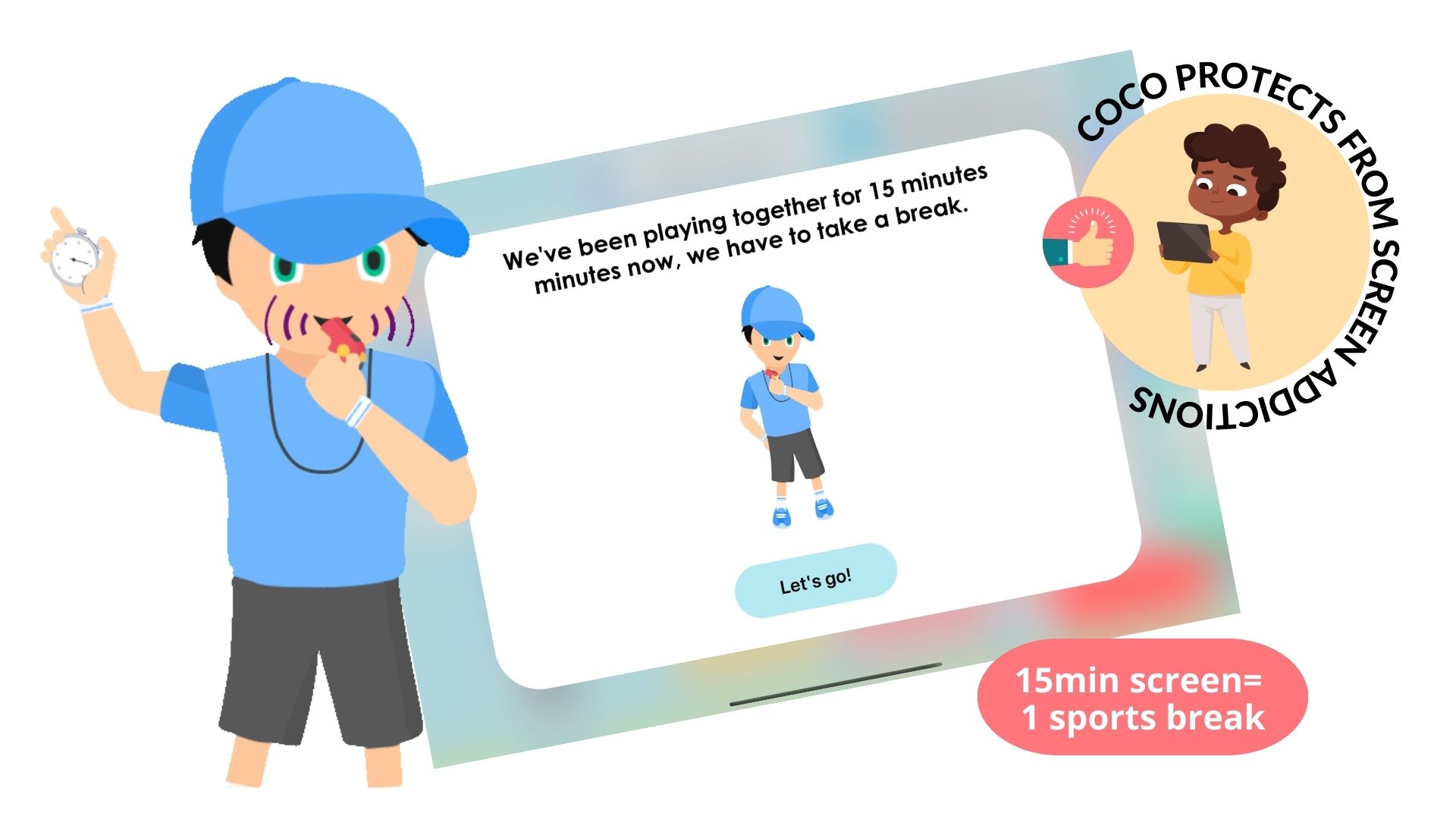
The integration of regular sports breaks, such as in the “Coco Thinks and Coco Moves“ program, offers an innovative and holistic method for supporting autistic children and their development, balancing cognitive and physical stimulations for their overall well–being.
Here are all the technical data sheets for the games presented, with the cognitive functions stimulated by each game.
